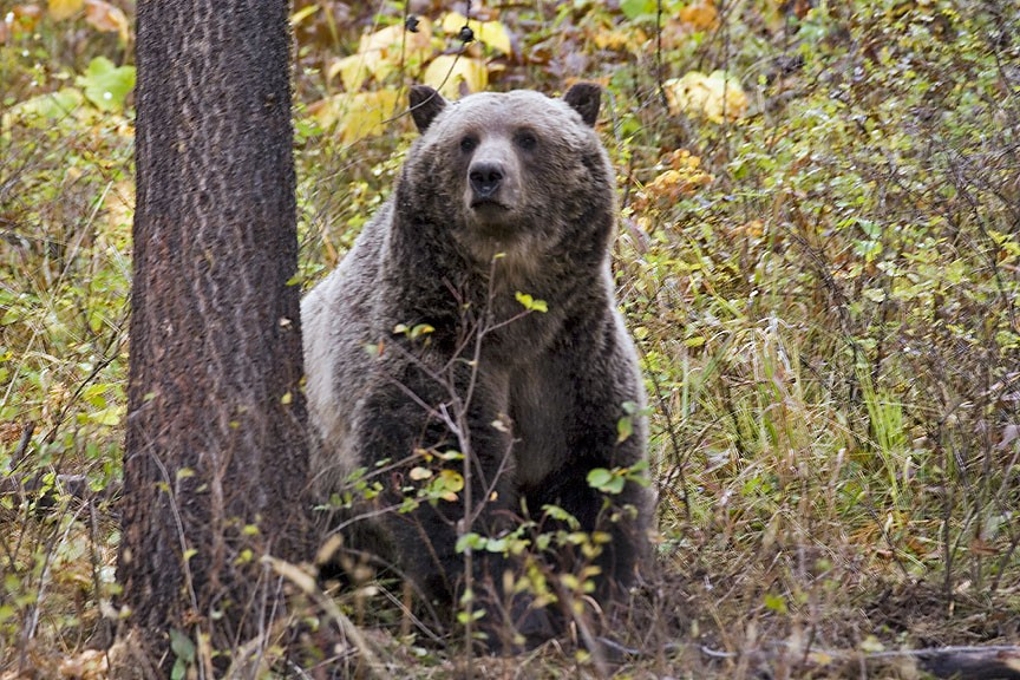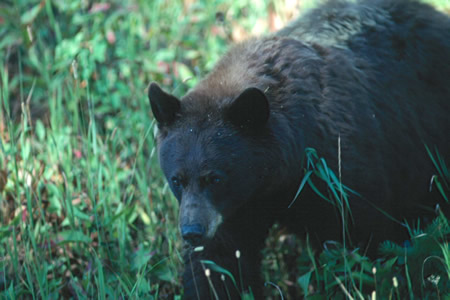

Montana grizzly bears are native, iconic omnivores that have high value to people and cultures across the state and around the world. Grizzly bears play important roles in ecosystems. At the same time, they can and do injure or kill people and livestock and cause property damage and economic loss, which may disproportionately affect certain individuals. Their potential presence is both valued and feared.
For Teachers/Educators: Grizzly Bears of Montana - A Resource Guide for Educators (PDF)
The grizzly bear (Ursus arctos) is a subspecies of brown bear.
It's important to know the difference between grizzly bears and black bears. Do you? Test your knowledge here.
Grizzly bears are generally larger than black bears and can be distinguished by longer, curved claws, humped shoulders, and a face that appears to be concave.
A wide range of coloration from light brown to black is common. Spring shedding, new growth, nutrition, and climate all affect coloration.
Guard hairs are often paled at the tips, hence the name “grizzly.”
In the lower 48 states, the average weight of grizzlies is 400 to 500 pounds for males and 250 to 350 for females.
Adults stand 3.5 to 4.5 feet at the hump when on all fours and may rear up on their hind legs to more than 8 feet.
The muscle structure in grizzly bears is developed for massive strength, quickness, and running speeds up to 35 miles per hour. Movement includes the normal position on all fours and an upright position on the hind legs that improves the opportunity to see and smell.
Grizzly bears are relatively long lived; individuals are known to live more than 30 years.
Mating typically occurs from late May through mid-July, with a peak in mid-June.
Twin cubs are born more often than single cubs; triplets are not uncommon.
Female grizzlies with cubs, or sows, are very defensive of their young. A female with her young exhibits an almost reflexive response to any surprise intrusion or perceived threat to her cub.
Bears den in winter due to a seasonal shortage of food, low environmental temperatures, and snow cover on the ground.
In Montana, bears typically den for 5 to 6 months during wintertime (approximately November-March).
Technically, grizzly bears in Montana do not hibernate. They enter into torpor, which is similar to hibernation, but is more like a deep sleep where the bears can still wake up easily in the den. In torpor the bears' temperature drops, their heart and breathing rates are significantly reduced, and they do not eat or release waste. However, the reduction in metabolic rate is still not as significant as true hibernators.
Major den excavation is completed in 3 to 7 days, during which a bear may move up to a ton of material. Dens consist of an entrance, short tunnel and a chamber with bedding material that has air pockets and traps body heat.
In Montana, grizzly bears tend to dig or locate dens on the mid to upper one-third of 30- to 60-degree slopes with northern exposures between 6,000 and 10,000 feet elevation.
Bears may lose 15 to 30 percent of their body weight during denning. Female grizzlies give birth and nurse their cubs in the den. For the 5 to 6 months they're in the den, they don't eat, drink, or eliminate waste.
Bears begin emerging from their dens in springtime, typically March-April.
Bears are opportunists and change their behavior to take advantage of new food sources.
While grizzly bears are technically classified as carnivores, they essentially act and live like omnivores. This is because they are adaptable and may eat insects, a variety of flowering plants, roots, tubers, grasses, berries, small rodents, fish, carrion (roadkill and other dead animals), other meat sources (like young and weakened animals), and even human garbage if it is easily accessible.
Grizzly bears can smell scents from over a mile away.
Grizzly bears are active and feeding for six to eight months in the spring, summer and fall of every year.
Bears in each ecosystem learn where and when particular foods are available through their personal experiences, and because of this, biologists have been able to learn and generally predict their seasonal distribution and movement.
Defense of a food supply is another cause of confrontation between humans and bears.
Adult bears are individualistic in behavior and normally are solitary wanderers. Except when caring for young or breeding, grizzly bears have solitary patterns of behavior.
Males roam the most, using areas from 600 to 1,000 square miles. Females use areas up to and beyond 100 square miles. Grizzlies may travel 20 to 40 miles a day.
Home range sizes of both grizzly and black bears vary in relation to food availability, weather conditions, and interactions with other bears. Individual bears may extend their range seasonally or from one year to the next.
Today, Montana has the largest remaining grizzly bear population in the United States, with the exception of Alaska.
Grizzly bears historically occupied most of Montana, as described in the journals of Lewis and Clark. Between 1800 and 1975 with westward expansion and European settlement, grizzly populations in the lower 48 states receded from estimates of more than 50,000 bears to fewer than 1,000. Livestock depredation control, habitat deterioration, commercial trapping, unregulated hunting, and protection of human life were the leading causes of decline in the overall grizzly bear population. Logging and recreational development also contributed to the increase in human-caused mortality of grizzly bears.
By 1922, the last of the California grizzly bears were gone, followed by Utah (1923), Oregon (1931), New Mexico (1933), and Arizona (1935). By the 1930s, occupied grizzly bear habitat in the lower 48 states had been reduced to the Yellowstone National Park area, the vicinity of Glacier National Park, the Middle Fork of the Flathead drainage (now the Great Bear Wilderness), and the Bob Marshall Wilderness.
While grizzly bears increasingly vanished across the West in the 20th Century, Montana stood out as a conservation leader. The Montana Fish and Game Department implemented management measures and promoted public awareness to try and slow the decline of grizzly bear populations. Montana abolished baiting and the use of hounds to hunt bears (1921), listed bears as a managed game species (1923), and prohibited the killing of cubs or females with cubs (1947). Some of the first scientific studies surrounding grizzly bears were conducted in Montana, including a 1941 survey by Robert “Bob” Cooney, Montana’s first wildlife biologist, and Ray Gibler in the Bob Marshall Wilderness Complex.
“There hadn’t been much of anything done about the grizzly but we did I’m sure help out in bringing them up from practically nothing to pretty reasonable numbers,” Cooney said in the PBS documentary “Back from the Brink.” “We found they needed quite a bit of care.”
The Montana Fish and Game Department continued grizzly bear surveys through the 1940s and 1950s. Major research was conducted in the 1970s with the Border Grizzly Bear Study led by Chuck Jonkel and the East Front Grizzly Bear Study led by Keith Aune. These were followed by the South Fork of the Flathead River study under Rick Mace and a study in the Mission Mountains by Chris Servheen.
John and Frank Craighead conducted landmark studies of grizzly bears in Yellowstone National Park from 1959 to 1972. These studies and newfound public awareness helped lead to the listing of the grizzly bear as a threatened species under the federal Endangered Species Act in the lower 48 states in 1975. Montana remains at the forefront of grizzly bear research today.
After decades of hard work by all Montanans, grizzly bear populations have reached and surpassed federal recovery goals in the Greater Yellowstone and Northern Continental Divide. Densities of grizzly bears are increasing. Populations are expanding into areas where they have not been for decades, including connectivity areas between recovery zones. These areas include a greater percentage of working private lands and places where the human population is expanding, creating a greater potential for conflicts.
Although grizzly bears in the lower 48 states remain under the jurisdiction of the U.S. Fish and Wildlife Service, much of the day-to-day management in Montana is done by Montana Fish, Wildlife & Parks within the bounds of what listing allows.
FWP maintains the integrity of its science, provides meaningful opportunities for people to engage in processes and management direction, and balances the diverse interests and values so that all have a voice in the future of grizzly bears in Montana.

Black bears are native omnivores that range across much of Montana. Many of the same characteristics and habits of grizzly bears listed above apply to black bears.
Montana offers world renowned, fair-chase black bear hunting, and black bears are a highly treasured big game animal in Montana.
From the high density bear populations of the maritime, wet, forested northwest corner of the state to the dry, rugged country in southeastern Montana, black bear hunters and enthusiasts enjoy a variety of season types and viewing opportunities.
Black bears are typically solitary creatures, except for a female with cubs, known as a family group, and during mating season, which peaks in May and June
Their range is extensive including most of Canada and the Rocky Mountain states to Mexico, as well as other US states.
You may encounter black bears in trees. While grizzly bears can climb trees, black bears are very proficient climbers.
They will often sleep in the crotch of branches.
The black bear is omnivorous, which means it eats vegetation, berries, insects, fish, and meat from small and big animals.
During the fall, they eat more than usual to gain body fat to sustain them through their winter "hibernation," which is not a true hibernation, but rather a deep sleep from which they can awaken quickly.
When food is abundant, they will eat up to 45 lbs. a day and put on 5 lbs. per day in preparation for winter.
The black bear's name is deceptive. It is a species name and does not refer to their color as they can range from pure black to cinnamon to blonde.
Black bears reach maturity in about 3 years and can live up to 25 years in the wild.
